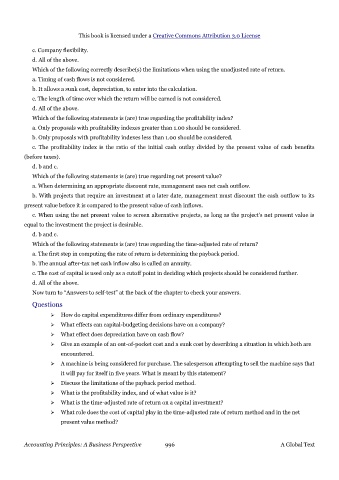Page 995 - Accounting Principles (A Business Perspective)
P. 995
This book is licensed under a Creative Commons Attribution 3.0 License
c. Company flexibility.
d. All of the above.
Which of the following correctly describe(s) the limitations when using the unadjusted rate of return.
a. Timing of cash flows is not considered.
b. It allows a sunk cost, depreciation, to enter into the calculation.
c. The length of time over which the return will be earned is not considered.
d. All of the above.
Which of the following statements is (are) true regarding the profitability index?
a. Only proposals with profitability indexes greater than 1.00 should be considered.
b. Only proposals with profitability indexes less than 1.00 should be considered.
c. The profitability index is the ratio of the initial cash outlay divided by the present value of cash benefits
(before taxes).
d. b and c.
Which of the following statements is (are) true regarding net present value?
a. When determining an appropriate discount rate, management uses net cash outflow.
b. With projects that require an investment at a later date, management must discount the cash outflow to its
present value before it is compared to the present value of cash inflows.
c. When using the net present value to screen alternative projects, as long as the project's net present value is
equal to the investment the project is desirable.
d. b and c.
Which of the following statements is (are) true regarding the time-adjusted rate of return?
a. The first step in computing the rate of return is determining the payback period.
b. The annual after-tax net cash inflow also is called an annuity.
c. The cost of capital is used only as a cutoff point in deciding which projects should be considered further.
d. All of the above.
Now turn to “Answers to self-test” at the back of the chapter to check your answers.
Questions
➢ How do capital expenditures differ from ordinary expenditures?
➢ What effects can capital-budgeting decisions have on a company?
➢ What effect does depreciation have on cash flow?
➢ Give an example of an out-of-pocket cost and a sunk cost by describing a situation in which both are
encountered.
➢ A machine is being considered for purchase. The salesperson attempting to sell the machine says that
it will pay for itself in five years. What is meant by this statement?
➢ Discuss the limitations of the payback period method.
➢ What is the profitability index, and of what value is it?
➢ What is the time-adjusted rate of return on a capital investment?
➢ What role does the cost of capital play in the time-adjusted rate of return method and in the net
present value method?
Accounting Principles: A Business Perspective 996 A Global Text

